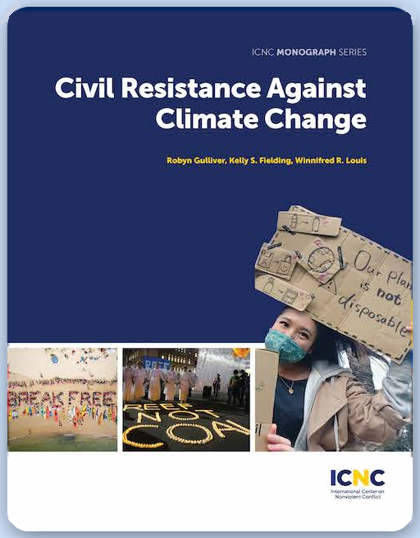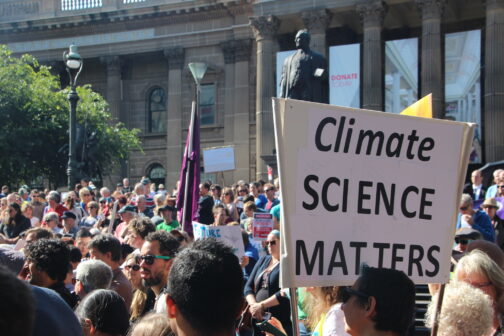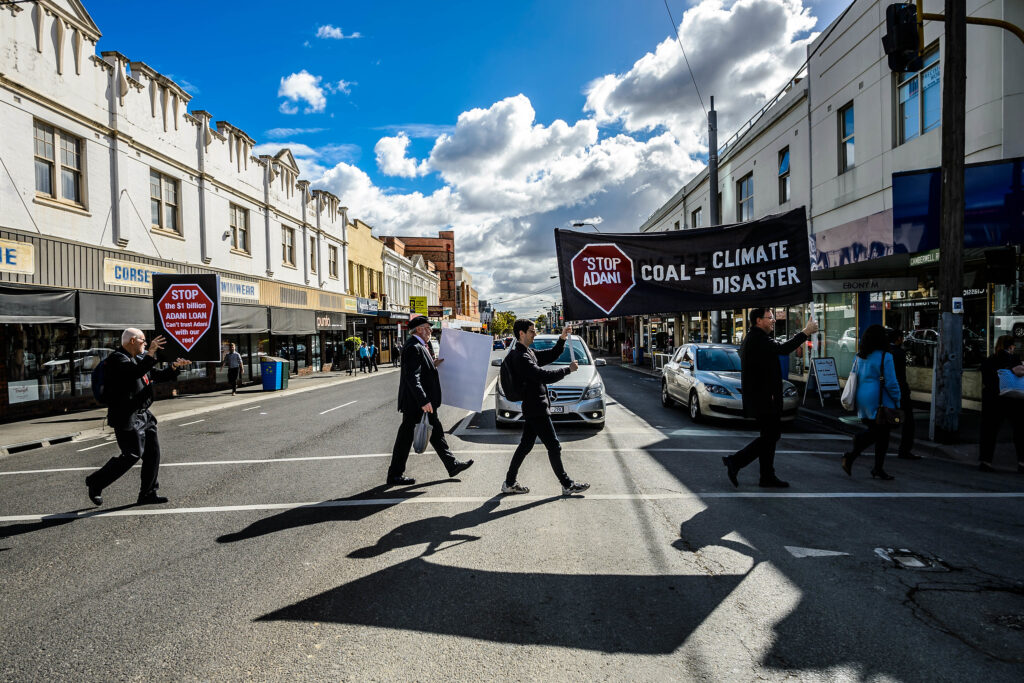Minds of the Movement
An ICNC blog on the people and power of civil resistance
by Elizabeth A. WilsonNovember 08, 2021

Civil Resistance Against Climate Change, by Robyn Gulliver, Kelly S. Fielding, and Winnifred R. Louis (ICNC Press, 2021).
Over the last five years, groups and organizations like Extinction Rebellion and Fridays for Future emerged to mobilize against climate change and adopted more radical measures than the environmental movement has traditionally used. Although temporarily disrupted by the COVID-19 pandemic, a global nonviolent civil resistance movement is coalescing and it is clear that its leaders have been studying and drawing lessons from the field of civil resistance studies.
Despite this trend, there was not—until recently—an empirically-based study of climate mobilization comparable to Chenoweth and Stephan’s study of pro-democracy movements in Why Civil Resistance Works. That changed with ICNC’s new monograph Civil Resistance Against Climate Change (2021) by Robyn Gulliver, Kelly S. Fielding, Winnifred R. Louis.
The authors of this publication created a dataset analogous to the NAVCO database created by Chenoweth and Stephan, smaller in scale (because limited to Australia) but sufficiently ambitious in scope to provide a basis for advancing civil resistance studies into the pressing area of climate change. The monograph is a major achievement that analyzes early trends of climate mobilization in an important national context and helps to identify questions for further research.
The methodology and main conclusions
Gulliver et al created an Australia-specific dataset of 492 environmental groups engaged in activism on one or more environmental issue, 193 climate change-related campaigns, and 27,934 unique events. They then coded them for event type to see how many civil resistance tactics were used in climate campaigns and how successful those campaigns were. Through websites, researchers identified groups engaged in environmental activism and identified their institutional status. The groups were manually coded for general focus, year of formation, and campaigns they were active in (193 of 906 discrete campaigns were identified as climate-related). Topic modeling was used to better understand how groups were communicating their issues.
Then, researchers scraped data from the groups’ associated Facebook pages to capture every event promoted by the group between 2010 and 2020, cross-referencing and eliminating duplicate events to identify 27,934 unique events which were then categorized into types (information-sharing activities, ecological activities, meetings and administrative events, social and fundraising events, and civil resistance tactics).

Thousands of Melburnians turned up and marched for science on April 22, #Earthday2017 (Australia). Credit: John Englart (CC BY-SA 2.0, unedited).
The monograph looked in-depth at the data from two quite different campaigns as case studies, the “Stop Adani” and Divestment campaigns, to better understand how climate mobilization is targeting corporations, as well as the most effective tactics. Both of these campaigns involved “directed networks” in which a centralized group of paid organizers researched the issues and created campaign materials to disseminate to smaller, less formally organized local groups.
“Stop Adani” targets a single activity (the creation of a thermal coal mine) of a single multinational corporation (The Adani Group). The Divestment campaign aims to persuade a wide array of investors to divest from the stocks of companies engaged in fossil fuel extraction. Norway’s Sovereign Wealth Fund, the Episcopal church, the Church of England, Rockefeller Brothers Fund, World Council of Churches, the California Academy of Sciences, the British Medical Association, and Newcastle, Australia are some of the organizations targeted by the campaign.
Finally, researchers mapped the empirical findings onto three different models (two specifically created with environment and climate change movements in mind) to understand the emergence and progression of social movements—Joanna Macy’s “Great Turning,” Jeremy Brecher’s “Climate Insurgency,” and the political process model.
In analyzing the empirical data, Gulliver et al found that groups concerned with climate-related issues (heating, mining, sustainability) were more likely to use civil resistance tactics than groups concerned with other environmental issues (pollution, waste). Directed network campaigns were also more likely than other campaigns to use civil resistance tactics, as the directed network structure means that many sub-groups can remain unincorporated, which in turn means that they face fewer legal constraints on their actions. Climate-related campaigns targeting corporations had a slightly higher success rate than those targeting politicians/political change, and actions targeting stakeholders were particularly effective, often achieving results in days. Given the difficulties of proving causality, the authors note that their data are cross-sectional and associative and thus cannot link specific civil resistance tactics to specific outcomes.
The overall results of the study are both encouraging and discouraging. A significant number of the campaigns achieved their stated outcomes, yet those successes were not enough to affect Australia’s climate policy overall. The authors call for further research to investigate which campaigns and campaign structures lead most consistently to reductions in carbon emissions.
Creating the dataset and carrying out the general and specific (case studies) analysis are the monograph’s most significant contributions. The monograph is weakest when it maps the empirical data onto the three social movement models it examines. The researchers show how the data reflect or don’t reflect different components of the models—i.e., the data are not designed to capture the shifts in consciousness identified by Macy, and do not support the importance placed on litigation by Brecher. However, the models do not clearly add to the empirical analysis, and likewise the empirical analysis does not clearly add to our understanding of the models.
Building on prior findings
While Gulliver et al abstain from reflecting on the broader theoretical applicability of civil resistance studies to the current mobilization against climate change, they put their finger on a major challenge that scholars and activists alike should recognize. The authors found that in almost half of the civil resistance tactics reported, it was difficult to ascertain who or what the action was targeting and what activists wanted the targets to do. This is not surprising, considering the nature of the climate problem and the diffuse nature of causality implicated by a fossil fuel-driven economic system. Indeed, most nonviolent movements studied by civil resistance scholars to date have been confined to domestic settings and the most studied movements have been aimed at overthrowing dictatorships or removing foreign occupiers. Climate change is a complex and overdetermined problem that affects all sectors of societies and all countries across the globe, requiring multi-level interventions and global coordination.

The environmental movement is indeed global. Here, the UK-based Kooyong Climate Coalition organized a "Stop Adani" demonstration in Camberwell on May 2, 2017. Credit: John Englart (CC-BY-SA, cropped).
Prior nonviolent movements have not had the aim of thorough-going system change encompassing complex and multiple sectors, including agriculture, finance, transportation, architecture, urban design, and most importantly, energy. Indeed, some nonviolent revolutions like the one ending Apartheid in South Africa have been criticized for ushering in only nominal democracy but doing little to change the entrenched racism and economic inequality in the country. Although civil resistance studies recognize the importance of what Gandhi called the “constructive program” of building parallel institutions, research has remained largely centered on actions resisting existing social and political structures, not building new ones. Gulliver et al attempted to track the creation of new institutions but found little evidence in the data that such constructive actions were being promoted, although green alternatives may be happening within existing institutions.
Of the two cases studies examined, the “Stop Adani” campaign had a goal that is arguably more analogous to the regime-change type of nonviolent campaign that Chenoweth and Stephan have studied. In the Adani case, there is a definable target, which is occupying a definable (if sprawling) physical space, and readily identifiable “pillars of support” (i.e., the government and business entities important for realizing the mine’s construction). Civil resisters were successful in extracting promises from Australian, Chinese, and Korean banks not to provide funding for the project. Contractors and engineering consultancy businesses were also targeted and ultimately backed out of contract negotiations with Adani. As the result of these efforts, civil resisters succeeded in delaying the mine’s construction by nine years. Despite those successes, the government continued to support the project and local communities wanted the jobs that the mine construction would bring. Extraction of coal began in 2021.
The Divestment campaign appears to have had greater success in persuading a wide range of investors to divest from fossil fuel stocks but the reasons for success were less clear. In the analysis, successful outcome was defined as a public statement announcing an intent to divest, rather than divestment itself. Although civil resistance tactics were occasionally used, they were not associated with successful outcomes, as in the Adani case; and some entities announced divestment without being the target of any campaign events at all. Researchers did not examine the effect of divestment on targeted companies’ stock prices, so the impact of the campaign on carbon emissions is unclear.
-
Despite these challenges, Civil Resistance Against Climate Change breaks new ground in our field. Further studies should build upon and expand its findings about the impact of civil resistance tactics against climate change, so that both practitioners and scholars may benefit.

Elizabeth A. Wilson
Elizabeth A. Wilson is the author of People Power and International Human Rights: Creating a Legal Framework (International Center on Nonviolent Conflict, 2017). She is a human rights lawyer, currently visiting scholar at Rutgers Law School-Newark and formerly Assistant Professor of English at Yale University.
Read More